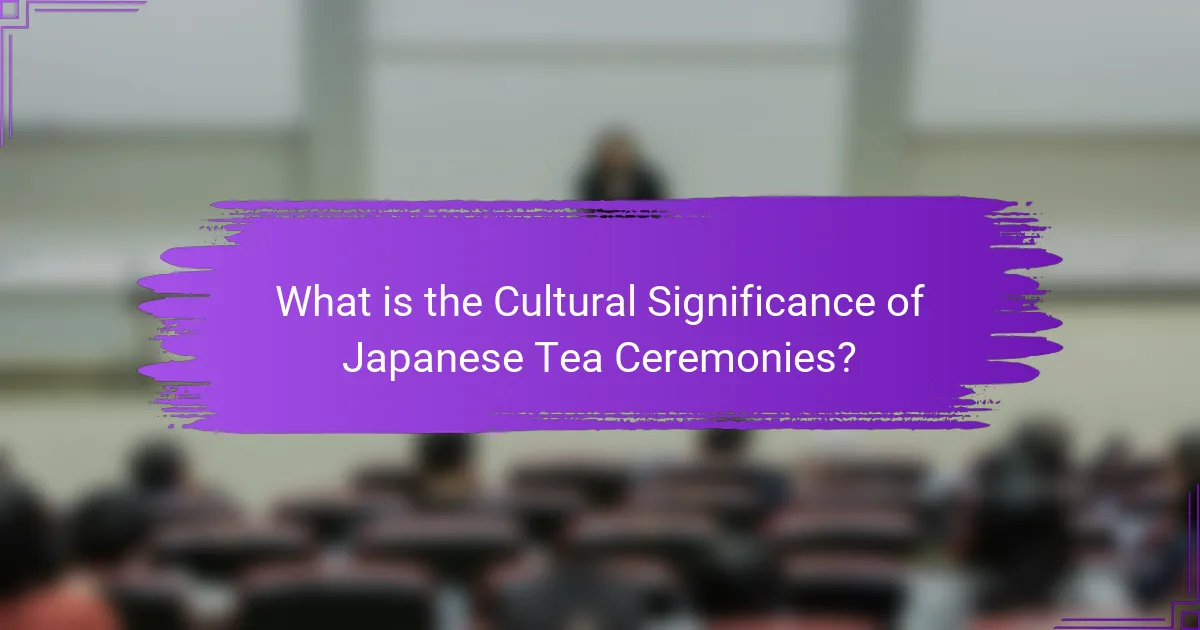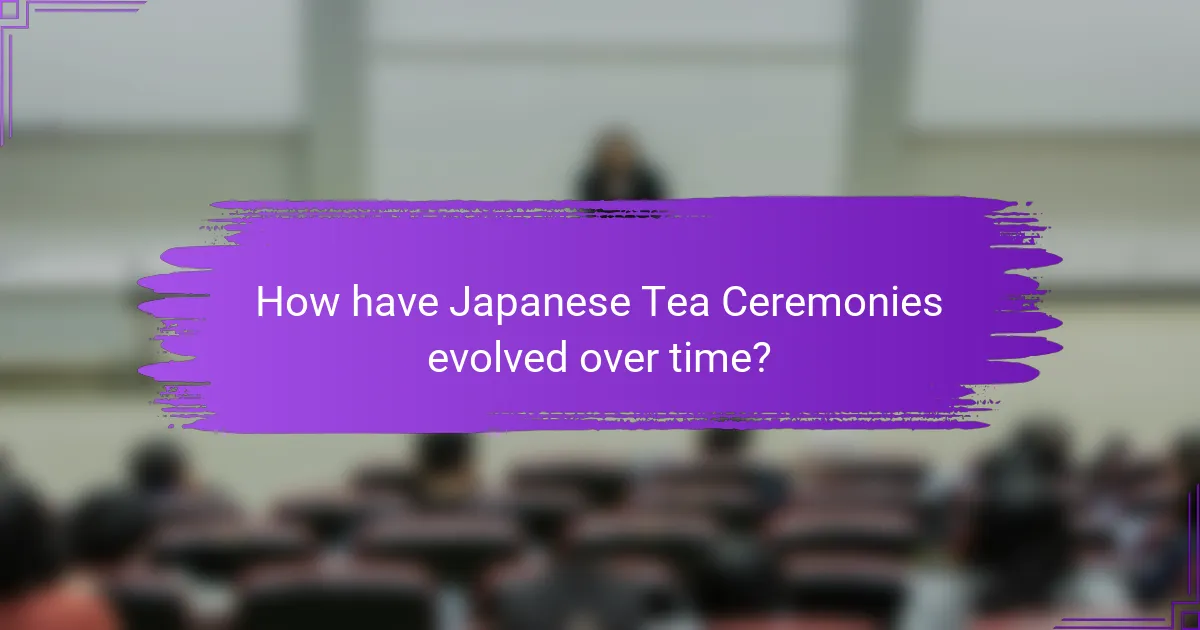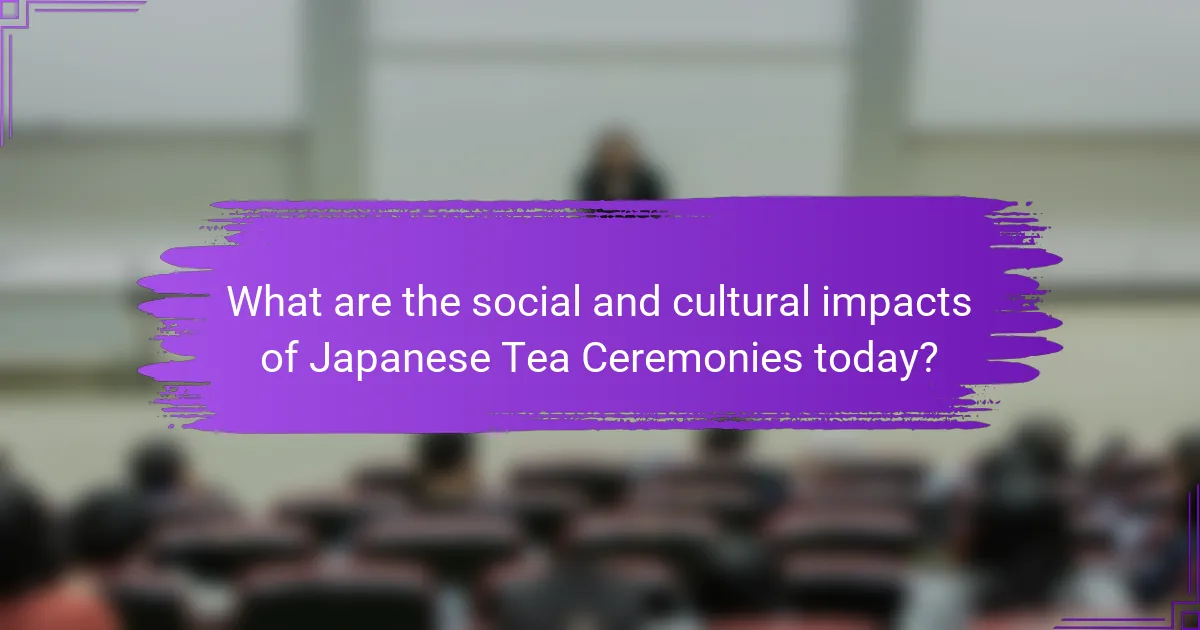
What is the Cultural Significance of Japanese Tea Ceremonies?
Japanese tea ceremonies hold deep cultural significance in Japan. They embody principles of harmony, respect, purity, and tranquility. These ceremonies are rooted in Zen Buddhism, emphasizing mindfulness and the aesthetic appreciation of simplicity. The ritualistic preparation and serving of tea promote social bonding and communication among participants. Historically, tea ceremonies have been a means of demonstrating hospitality and grace. They also serve as a form of artistic expression through the selection of utensils, the arrangement of flowers, and the choice of tea. In contemporary society, these ceremonies continue to foster cultural identity and community connection, reflecting Japan’s rich heritage.
How did Japanese Tea Ceremonies originate?
Japanese tea ceremonies originated in the 9th century with the introduction of tea to Japan from China. The practice evolved during the 12th century when Zen Buddhism influenced its development. Monks used tea to enhance meditation and maintain alertness. By the 15th century, tea drinking became a social ritual among the samurai class. The tea ceremony was formalized by tea masters like Sen no Rikyū, who emphasized simplicity and harmony. This led to the establishment of the traditional tea ceremony as a cultural art form. Today, it reflects Japanese aesthetics and philosophy, emphasizing mindfulness and respect.
What historical events influenced the development of tea ceremonies?
The development of tea ceremonies was influenced by several historical events. The introduction of tea to Japan from China in the 9th century marked the beginning of its cultural significance. By the 12th century, Zen Buddhism began to shape tea practices, emphasizing mindfulness and simplicity. The establishment of the Muromachi period in the 14th century further formalized tea ceremonies as a social ritual among the samurai class.
In the 16th century, tea master Sen no Rikyū refined the tea ceremony, promoting the principles of harmony, respect, purity, and tranquility. The Edo period (1603-1868) saw the tea ceremony evolve into a symbol of status and sophistication among the elite. The Meiji Restoration in the late 19th century led to modernization, impacting traditional practices, yet the tea ceremony remained a revered cultural art form.
These events collectively contributed to the rich history and significance of tea ceremonies in Japanese culture.
Who were the key figures in the history of Japanese tea ceremonies?
The key figures in the history of Japanese tea ceremonies include Sen no Rikyū, Takeno Jōō, and Urasenke. Sen no Rikyū is widely regarded as the most influential tea master. He refined the tea ceremony into a spiritual and aesthetic practice in the 16th century. Takeno Jōō was an earlier tea master who emphasized simplicity and natural beauty. Urasenke is one of the main schools of tea ceremony founded by Sen no Rikyū’s descendants. Each of these figures contributed significantly to the development and philosophy of the tea ceremony. Their teachings and practices continue to influence modern tea ceremonies in Japan.
What are the core rituals involved in Japanese Tea Ceremonies?
The core rituals involved in Japanese Tea Ceremonies include the preparation and serving of matcha tea. These rituals emphasize harmony, respect, purity, and tranquility. The host prepares the tea in a specific manner, often using traditional utensils. Guests are invited to appreciate the aesthetics of the tea and the surrounding environment. Each movement is deliberate and reflects mindfulness. The ceremony often includes the presentation of seasonal sweets. Guests are encouraged to express gratitude and appreciation for the host’s efforts. The experience fosters a deep connection between participants and their surroundings.
What specific steps are followed during a traditional tea ceremony?
The specific steps followed during a traditional tea ceremony include preparation, greeting guests, serving tea, and concluding the ceremony. Initially, participants prepare the tea utensils and ingredients. This includes the tea bowl, whisk, and matcha powder. Next, the host greets the guests with a bow and offers them sweets. The host then prepares the tea by whisking matcha with hot water in the bowl. After serving the tea, guests express their gratitude. Finally, the host concludes the ceremony by cleaning the utensils and bowing again to the guests. Each step emphasizes respect and mindfulness, embodying the principles of harmony and tranquility.
How do the rituals reflect Japanese cultural values?
Japanese tea ceremony rituals reflect core cultural values such as harmony, respect, purity, and tranquility. Each ritual element emphasizes the importance of mindfulness and presence. The meticulous preparation of tea signifies respect for nature and the seasons. Participants engage in a shared experience, fostering a sense of community and connection. The use of simple, natural materials highlights the value placed on simplicity and humility. Historical practices, such as the influence of Zen Buddhism, further reinforce these values. Overall, rituals serve as a medium for expressing and preserving Japanese cultural identity.
Why are Japanese Tea Ceremonies considered an art form?
Japanese Tea Ceremonies are considered an art form due to their intricate rituals and aesthetic principles. Each ceremony emphasizes harmony, respect, purity, and tranquility. The careful preparation and presentation of tea reflect a deep appreciation for beauty and mindfulness. The utensils used, such as tea bowls and whisk, are often handcrafted and hold significant artistic value. Additionally, the setting plays a crucial role, often designed to enhance the overall experience. The historical roots of the ceremony trace back to the 15th century, where it evolved as a cultural practice. This evolution incorporated various artistic elements, including calligraphy, flower arrangement, and architecture. Thus, Japanese Tea Ceremonies embody a synthesis of art, culture, and philosophy.
What artistic elements are incorporated into the tea ceremony?
The tea ceremony incorporates various artistic elements such as calligraphy, flower arrangement, and pottery. Calligraphy is often displayed on scrolls, showcasing the beauty of written language. Flower arrangement, known as Ikebana, emphasizes harmony and balance in nature. Pottery plays a crucial role, with tea bowls crafted to enhance the aesthetic experience. Each element reflects principles of simplicity and elegance. These artistic components contribute to the overall atmosphere of mindfulness and appreciation in the tea ceremony. The integration of these elements creates a holistic experience that resonates with cultural values.
How is aesthetics important in the tea ceremony experience?
Aesthetics is crucial in the tea ceremony experience as it enhances mindfulness and appreciation. The visual elements, such as the arrangement of utensils and the setting, create a harmonious atmosphere. This careful attention to detail reflects principles of simplicity and natural beauty. The aesthetic experience encourages participants to engage fully with the moment. Historical texts, like “The Book of Tea” by Okakura Kakuzō, emphasize the importance of aesthetics in cultivating a serene environment. This focus on beauty fosters a deeper connection between the participants and the tea itself. Thus, aesthetics play a vital role in elevating the overall experience of the tea ceremony.

How have Japanese Tea Ceremonies evolved over time?
Japanese tea ceremonies have evolved significantly from their origins in the 9th century. Initially influenced by Chinese customs, the practice emphasized simplicity and mindfulness. Over the centuries, the tea ceremony became more structured, integrating Zen Buddhist principles. By the 15th century, the tea ceremony was formalized further by figures like Sen no Rikyū. This led to the development of specific rituals and aesthetic principles, such as wabi-sabi. In modern times, the tea ceremony has adapted to contemporary culture. While traditional elements remain, there are variations that cater to different audiences and settings. Today, tea ceremonies can be both formal and casual, reflecting a blend of tradition and modernity.
What changes have occurred in tea ceremonies during the Meiji period?
Tea ceremonies during the Meiji period underwent significant changes. The Meiji Restoration in 1868 led to modernization and Western influence in Japan. Traditional tea practices were adapted to reflect these societal shifts. The formalized rituals became less rigid and more accessible to the public. There was an increase in the use of Western-style tea utensils. The introduction of new tea varieties also occurred. Additionally, the focus shifted towards social gatherings rather than strict ceremonial observance. These changes reflected broader cultural transformations in Japan during this era.
How did Western influence shape modern tea practices?
Western influence shaped modern tea practices by introducing new consumption styles and preferences. The British popularized afternoon tea in the 19th century, altering traditional Japanese tea customs. This practice emphasized social gatherings and light snacks alongside tea. The introduction of tea bags streamlined the brewing process, making tea more accessible. Additionally, Western cafes began to offer a variety of tea blends, diversifying options for consumers. The globalization of tea culture led to the fusion of Eastern and Western practices. Events like tea festivals now celebrate both traditions, reflecting a blend of influences. Overall, Western influence has significantly modified how tea is enjoyed today.
What adaptations have been made to the rituals in contemporary society?
Contemporary society has adapted Japanese tea ceremonies by incorporating modern elements and simplifying traditional practices. Many ceremonies now occur in less formal settings, such as homes or cafes. The use of pre-packaged tea and utensils has increased for convenience. Additionally, time constraints have led to shorter ceremonies, focusing on key elements rather than full rituals. Social media influences have introduced visual aesthetics, making the ceremonies more appealing to younger generations. These adaptations help maintain cultural relevance while appealing to contemporary lifestyles.
In what ways are modern practices of tea ceremonies different from traditional ones?
Modern practices of tea ceremonies differ from traditional ones in several key aspects. Traditional tea ceremonies emphasize strict rituals and protocols. These rituals often include specific movements and the use of particular utensils. Modern practices tend to be more relaxed and informal. Participants may prioritize personal expression over rigid adherence to tradition.
In traditional ceremonies, the preparation of matcha is meticulous and time-consuming. Modern ceremonies may simplify this process. Traditional ceremonies often occur in serene, dedicated tea rooms. Modern practices might take place in various casual settings.
Additionally, traditional ceremonies are deeply rooted in Zen Buddhism. Modern interpretations may incorporate diverse cultural influences. The focus of traditional ceremonies is on mindfulness and appreciation of aesthetics. Modern practices may also emphasize social interaction and enjoyment.
Overall, the evolution reflects changing societal values and lifestyles.
What new elements have been introduced into the tea ceremony experience?
New elements introduced into the tea ceremony experience include contemporary artistic expressions and innovative tea blends. These modern adaptations aim to attract a younger audience. Additionally, some ceremonies now incorporate technology, such as virtual reality experiences. These changes reflect a blend of tradition and modernity. Various tea houses have begun hosting themed ceremonies, which enhance the cultural experience. Collaborations with local artists have also emerged, showcasing unique tea ware. These elements create a more dynamic and engaging atmosphere. The integration of these new aspects maintains the relevance of tea ceremonies in today’s society.
How do modern tea ceremonies appeal to younger generations?
Modern tea ceremonies appeal to younger generations by emphasizing mindfulness and connection. These ceremonies offer a break from fast-paced lifestyles. They promote social interaction in a serene environment. Younger individuals appreciate the aesthetic aspects of tea preparation. The use of vibrant and unique tea blends attracts their interest. Workshops and classes make the experience more accessible and engaging. Social media showcases these ceremonies, enhancing their visibility. This fusion of tradition and contemporary culture resonates with younger audiences.

What are the social and cultural impacts of Japanese Tea Ceremonies today?
Japanese Tea Ceremonies today foster social cohesion and cultural identity. They serve as a platform for community interaction. Participants engage in a shared experience that emphasizes harmony and respect. The rituals promote mindfulness and appreciation of aesthetics. This practice connects individuals to Japan’s historical traditions. It also encourages the preservation of cultural heritage. Modern adaptations include workshops and public events. These adaptations broaden accessibility and interest among diverse audiences.
How do tea ceremonies foster community and connection?
Tea ceremonies foster community and connection by creating a shared space for participants to engage in mindfulness and appreciation. The ritualistic nature of the ceremony encourages attendees to focus on the present moment. This shared experience promotes a sense of belonging among participants. Historically, tea ceremonies have been a social gathering, reinforcing bonds among family and friends. The act of preparing and serving tea is a gesture of hospitality, deepening interpersonal relationships. Additionally, the principles of respect, harmony, purity, and tranquility inherent in the ceremony cultivate a positive communal atmosphere. Studies have shown that such social rituals enhance emotional well-being and social cohesion.
What role do tea ceremonies play in social gatherings?
Tea ceremonies serve as a vital social function in gatherings. They promote mindfulness and foster a sense of community. Participants engage in a shared experience that emphasizes respect and harmony. The ritualistic nature of tea preparation and consumption encourages meaningful interactions. Historically, tea ceremonies have been a means of cultivating relationships. They often symbolize hospitality and cultural heritage. In modern contexts, these ceremonies continue to strengthen social bonds. They provide a space for reflection and connection among diverse groups.
How do they promote cultural exchange in a globalized world?
Japanese tea ceremonies promote cultural exchange in a globalized world through their emphasis on hospitality and mindfulness. These ceremonies invite participants from diverse backgrounds to engage in a shared experience. This interaction fosters understanding and appreciation of Japanese culture.
Additionally, tea ceremonies are often showcased at international cultural festivals. Such events highlight the artistry and philosophy behind the rituals. The global interest in Japanese tea culture has led to workshops and classes worldwide. These educational opportunities allow people to practice the rituals and learn about their significance.
Moreover, the aesthetic aspects of tea ceremonies, such as the use of traditional utensils, inspire artists and designers globally. This cross-cultural influence can be seen in various art forms, from ceramics to fashion. Overall, the tea ceremony serves as a bridge connecting people across cultures, enhancing mutual respect and collaboration.
What are the educational aspects of Japanese Tea Ceremonies?
Japanese Tea Ceremonies offer various educational aspects. They teach participants about mindfulness and the importance of being present. The ceremonies emphasize respect for nature and the seasons. Participants learn about the history and cultural significance of tea in Japan. They also gain knowledge of traditional Japanese aesthetics, such as simplicity and harmony. The preparation and serving of tea involve precise techniques, promoting skill development. Additionally, the ceremonies foster social skills through interaction and communication. Overall, they provide a holistic educational experience rooted in Japanese culture and philosophy.
How are tea ceremonies taught and preserved in modern Japan?
Tea ceremonies in modern Japan are taught through formal schools and informal community gatherings. Various tea schools, such as Urasenke and Omotesenke, offer structured lessons. Students learn not only the techniques but also the philosophy behind the tea ceremony.
These schools often have a hierarchical structure where advanced practitioners mentor beginners. Traditional practices are preserved through meticulous training in the art of tea preparation and presentation.
Workshops and cultural events also promote awareness and appreciation of tea ceremonies. Additionally, local tea associations organize events to engage the community.
The integration of tea ceremonies into cultural festivals helps maintain their relevance. Schools and cultural institutions collaborate to ensure the teachings are passed down to younger generations.
This systematic approach ensures that the intricate rituals and values of the tea ceremony remain alive in contemporary society.
What resources are available for those interested in learning about tea ceremonies?
Books on tea ceremonies provide foundational knowledge. “The Book of Tea” by Okakura Kakuzō explores philosophy and aesthetics. Online courses offer practical lessons. Websites like Udemy and Coursera host structured programs. Local workshops teach hands-on skills. Community centers often organize events. Museums frequently have exhibitions on tea culture. Documentaries and videos on platforms like YouTube showcase ceremonies in action.
What practical tips can enhance the experience of participating in a Japanese Tea Ceremony?
To enhance the experience of participating in a Japanese Tea Ceremony, focus on mindfulness and respect for the ritual. Arrive on time to show respect for the host and the ceremony’s structure. Dress appropriately in traditional attire, such as a kimono, to immerse yourself in the cultural experience. Observe the movements and actions of the host carefully, as each gesture holds significance. Engage in quiet reflection during the ceremony, which emphasizes mindfulness and appreciation of the moment. Taste the tea slowly to savor its flavors, enhancing your sensory experience. Participate in the conversation politely, discussing the aesthetics and philosophy behind the ceremony. Lastly, express gratitude to the host after the ceremony, reinforcing the bond created through this cultural practice.
Japanese tea ceremonies are a significant cultural practice in Japan, embodying principles of harmony, respect, purity, and tranquility. The article explores their historical origins, rooted in Zen Buddhism, and the evolution of rituals over time, highlighting key figures like Sen no Rikyū who formalized these practices. It delves into the core rituals, artistic elements, and the impact of modernization on tea ceremonies, emphasizing their role in fostering community, cultural identity, and mindfulness in contemporary society. Additionally, the article discusses educational aspects and resources available for those interested in learning about this cultural art form.